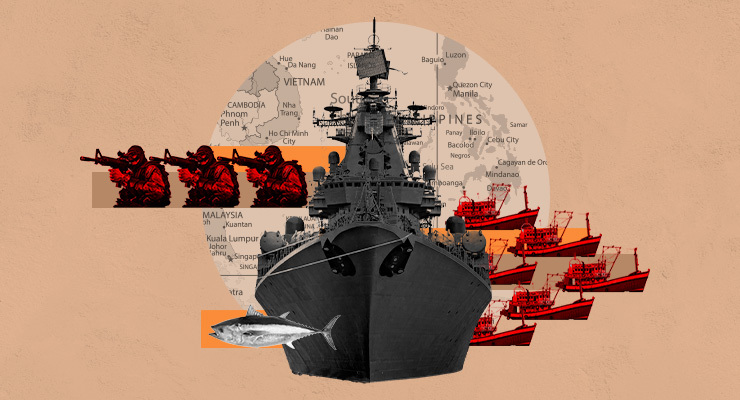
This is part two of a series. Read part one here.
China’s deep water fishing fleet is the world’s largest by far, with estimates ranging as high as 17,000 vessels — including at least 1000 registered in other countries.
As well as being responsible for illegal offshore fishing, parts of the fleet are souped-up paramilitary vessels that act as a seafaring militia. They are equipped with heavy-duty water cannons, and there are at least 84 purpose-built vessels with reinforced steel hulls for ramming — along with hundreds, possibly thousands, of other fishing vessels.
This is an effective naval reserve force which has twin aims: to use its muscle against rival fishing fleets and as a disguised military force for any harder-edged activities with the aim of establishing China’s maritime sovereignty.
The elite part of this fleet has been named the People’s Armed Forces Maritime Militia by the US Department of Defense — and with good reason. It is under the direct command and control of the People’s Liberation Army and has been an integral part of the Chinese Communist Party’s defence strategy since the 1950s and emerged on the global stage in the 1974 stoush with Vietnam over the Paracel Islands.
Since then it has grown and cemented itself as the third arm of China’s maritime defence strategy, led by the PLA’s navy and the Chinese Communist Party coastguard.
Over the past decade it has been a regular player in China’s adventurism into the East and South China seas where it has disputed territory in the east with Japan, and seven nations, including Taiwan, in the south.
It played a central role in China’s seizure of Scarborough Shoal in 2012 — a territory claimed by the Philippines — as well deployment of a Chinese oil rig in Vietnamese waters in 2014, although China later moved the structure. Since the China’s South China Sea artificial island outposts were completed in 2016, militia boats have regularly patrolled the disputed area — including blocking US ships. In 2018 about 100 militia boats were deployed near Philippine-occupied Thitu Island, and in 2021 a similar number surrounded the Whitsun Reef, also in the Philippines exclusive economic zone.
The militia boats are owned by large fishing companies and crewed by fishermen, many of whom in recent years have had training by the PLA’s navy and the coastguard. The force ultimately reports to China’s military commander-in-chief, Xi Jinping, also the CCP secretary-general and president.
Internationally, the militia is classified as a naval auxiliary force for which definitions are loose. South-East Asian countries with exclusive economic zones that China encroached upon are already increasingly using their coastguards to support their territorial claims. But only Vietnam — which operates under a near identical Leninist-Marxist system of government to its northern neighbour — operates a similar fleet, and it is bulking up. In January Vietnam held a flag-raising ceremony for a five-vessel fleet that China ironically claimed is equipped with heavy machine-guns.
The militia and its grey zone operations obviously pose a conundrum for countries at its receiving end, and others such the US and Australia who are concerned about China’s maritime activities. But according to a detailed report by the US Center for Strategic and International Studies, its activities violate international law.
The report said: “Efforts to block the lawful activities of other claimant states within their exclusive economic zones are in violation of the United Nations Convention on the Law of the Sea and customary international law. Unsafe manoeuvres intended to impede the operations of foreign ships by creating a risk of collision violate the International Maritime Organization’s regulations for preventing collisions at Sea, or COLREGS.“
In 2019, outgoing US chief of naval operations Admiral John Richards warned his Chinese counterpart, Vice-Admiral Shen Jinlong, that the US Navy would respond to aggressive acts by militia boats and ships as though they were part of the armed forces.
The 2020 decision by Papua New Guinea to allow China to build a fishing port in remote Daru which lies about 200km from the Australian mainland turned heads in Canberra, particularly since there are no abundant fishing grounds nearby. Although it now seems the port may not eventuate — at least at this time — and Australia has countered with aid to PNG for port upgrades, it signals China’s intent.
Failing to confront the militia normalises Beijing’s presence in other nations’ territorial seas, the Australian Institute of International Affairs wrote in February this year.
“If allowed to continue unchallenged, China could effectively dictate terms to other South China Sea littoral states on where they can fish, where oil companies can drill, and so forth. Naturally this would give Beijing significant leverage in the region and open opportunities to forge political agreements — reducing the scope for military cooperation with the US and bringing littoral states into the Chinese orbit,” it wrote.
The militia’s emergence and the probability that it is moving closer to Australia would seem like the ideal opportunity for Canberra to improve its links with many of our South-East Asian neighbours, or risk another nasty surprise like the impending China/Solomons deal.








Is this the same Liberal Party that cut back Aid to the Pacific Nations, restricted the cover of Radio Australia, Sold the port of Darwin, and made snide remarks about Island nations being inundated by increasing sea levels?
They now ask why these nations are amenable to offers of aid from China .
Yep . . . they are the one’s.
But we are smart – our RAN training vessel MV Sycamore (Not HMAS as previous training vessels as it does not necessarily have a navy crew) was bought from France and built in Damen Song Shipyards Vietnam thanks to Tony Abbot.
As the communists built it I wonder if it will be useful to patrol with their fishing fleet when they take it back?
Operational Lease of the Port of Darwin actually. Not sold.
Much like Hong Kong We will be able to take it back when hell freezes over
Not really the same. HK belongs to China and is back with them. Darwin is just an Operational Lease but Sovereign rights remain with Australia. Even the Defence Department have said the lease is not a security issue. They don’t own the Port, the just manage its operations.
Exactly, media are not interested in highlighting these issues by going back in time because it might embarrass the LNP?
Well we had better keep in good with China – hang on don’t we have superior military forces in the form of Vice Admiral Air Commodore General ‘Spud’ Dutton and his Tanks and Howitzers and Submarines all manned and ready to so those awful Chinese off???
sort
Or . . . Snort?
Australia is fortunate to have that master strategist Bob Katter and by his logic the solution is simple – arm every Australian fisherman. A rifle in every tinnie. This will work very well with his “shotguns for schoolies” programme.
My father was a sniper during WW11. He said one placed shot could keep a lot of men close to the ground and going nowhere, for a long time.
I saw a fleet (My count was over 300) of steel hulled about 65 footers tied up in a fishing port in Tuall, a remote Indonesian port.
We were bring a cat back from Bangkok.
I was very surprised, we didn’t go in too close because there appeared to be security on the docks watching us.
It never occurred to us that they could be Chinese, thinking back on it, highly probable.
This is the sort of actual threat from China I’d be worried about. Not some military attack, but whittling away at things like other countries exclusive fishing zones.
Every country tries it on, China just does it to scale is all.
Shit! Now you have my full attention Michael. The time for kicking each other’s backsides is over. Our Nation has dropped the ball big-time. The anticipated new world era based upon Climate threat remains. But clearly we also need more of the Hugh White commentary and far, far, less of domestic politics focussed upon personal political ambition. Let’s get this rabid General Election, hopefully over with fresh eyes and national, democratic energisation. Clearly, we do need to pay attention!